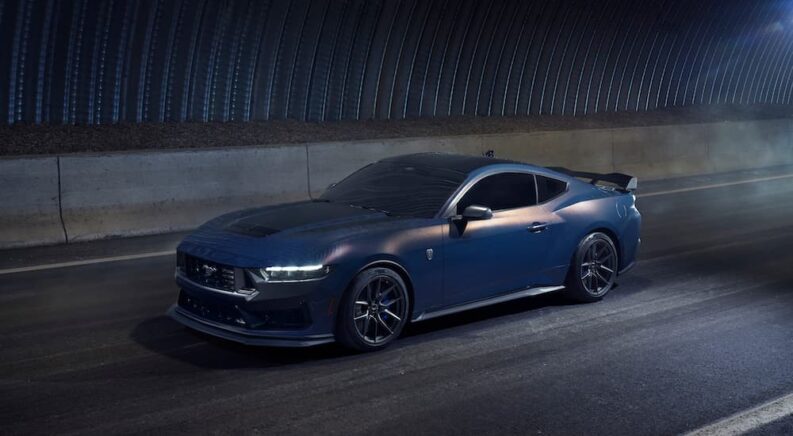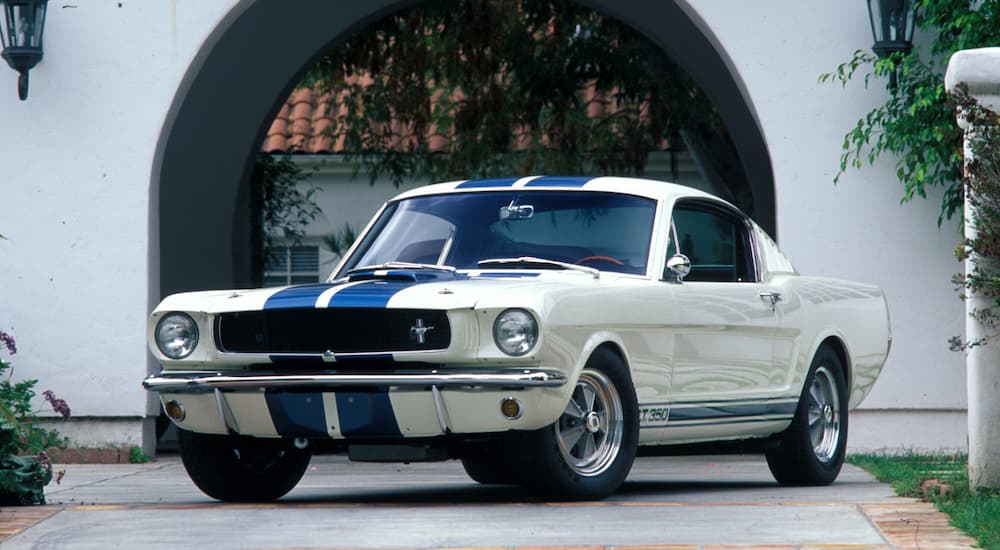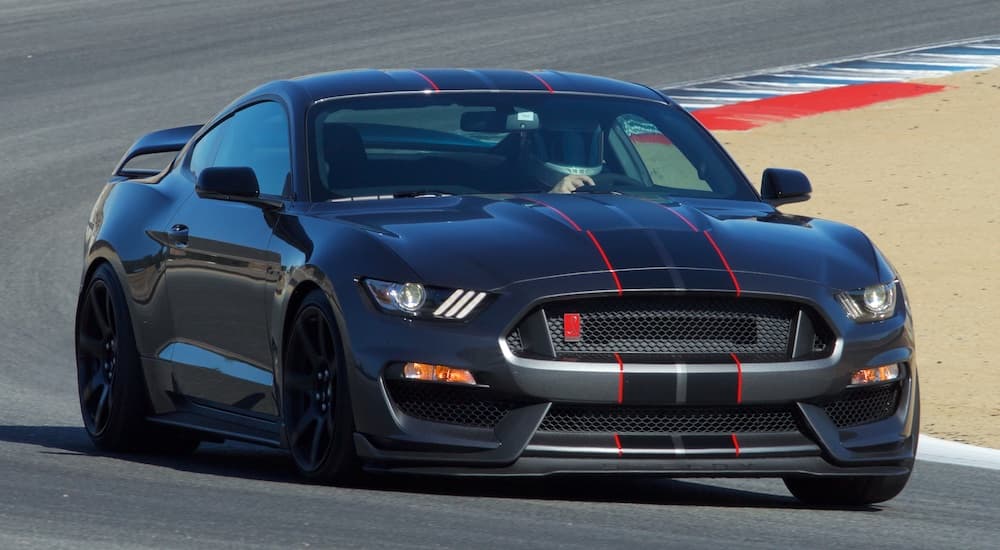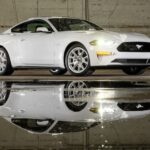2025 marks the Ford Mustang’s diamond jubilee as this quintessential pony car celebrates 60 years on the market. Ford is doing its part to get in on the festivities, gifting 2025 Ford Mustang drivers with everything from a 315-hp turbo four-cylinder to a 500-hp V8 Dark Horse and a 60th Anniversary Edition that’s limited to a historically relevant 1,965 units.
The 60th Anniversary Edition packs a number of exclusive features, from 20-inch wheels with red aluminum center caps to a retro digital gauge cluster that’ll give drivers flashbacks to the mid-1960s. The Dark Horse is the obvious highlight from a performance perspective, packing adaptive dampers and 19-inch Pirelli P Zero PZ4 tires to turn in a track-worthy zero-to-sixty time of 4.1 seconds.
In recognition of the Mustang’s 60 years of pony car dominance, we thought it would be the perfect time to look back on some of the best Mustang models to ever grace the street. In this case, best doesn’t necessarily mean fastest or most powerful. Ford has produced a number of niche Mustang models over the years, from exclusive one-offs to the renowned Shelby collaborations that seem to pop up every couple of years.
So, from the original Shelby collab to a NASCAR-ready racer and some notable high points of Mustang design, let’s climb behind the wheel and take a drive through the history of Ford’s segment-defining pony car.
#1. 1965 Shelby Mustang GT350
Classic.com Average Price: $372,661
Limited-edition models and high-performance variants have been a part of the Mustang’s DNA since its earliest days. Just take the 1965 Shelby Mustang GT350. Produced in collaboration with the speed freaks over at Shelby American, the GT350 was an early example of just how powerful the Mustang could be. Carroll Shelby and Co. took a fastback ’65 Mustang and treated it to a track-worthy makeover while managing to keep the fledgling pony car street-legal.
The Mustang was outfitted with a 4.7-liter Windsor V8 that, thanks to the ultra-lightweight design and the addition of a four-barrel Holley carburetor, was able to churn out 306 hp and 329 lb-ft of torque. Shelby also fitted the GT350 with its proprietary Cobra hi-riser intake manifold, as well as Tri-Y headers and upsized rear drum brakes cribbed from the Ford Galaxie.
The GT350 would not be the last collaboration between Ford and Shelby, but it did set the standard for all future models. In addition to the road-legal GT350, Shelby also produced 34 race-spec models that could come to dominate the Sports Car Club of America (SCCA) circuit for much of the mid- to late-1960s. This includes one overachieving GT350 that would become the three-time consecutive winner of the SCCA’s B-Production class, earning its fair share of checkered flags and helping to establish the Mustang legend in the process.
Ford would follow the 1965 Shelby GT350 with a more practical, comfortable version with a rear seat and available automatic in 1966—however, for those looking to get a taste of race day every time they step behind the wheel, there’s no substitute for the original 1965 Shelby Mustang GT350.
#2. 1969 Ford Mustang Boss 429
Classic.com Average Price: $328,161
We have NASCAR to thank for one of the most thrilling Mustang models of all time. In order to compete in the vaunted American racing series, a NASCAR vehicle also had to be offered as a production model with a run of at least 500 units. This rule serves two distinct purposes: preventing brands from creating one-off supercars that endanger the spirit of fair competition and allowing the racing series to serve as a sort of 500-lap commercial for existing production models.
Ford wanted to unleash its new 429 V8 engine on the NASCAR circuit to compete with the reigning champ in the Chrysler 426 HEMI but knew that it would have to make it available to everyday drivers if it wanted to get the green light.
The result was the 1969 Ford Mustang Boss 429, a 450-hp beast that allowed all drivers to get a taste of life on a NASCAR oval. Squeezing the hulking V8 into the Mustang was no small task, requiring Ford engineers to fit the pony car with a specially modified front suspension that could handle the extra heft. Ford also relocated the battery to the trunk and added the Mustang’s first-ever rear sway bar to improve handling.
The 429-cubic-inch engine made the Mustang relatively weighty at 3,870 lbs, but when you really put the pedal to the metal, it was still able to deliver all the thrills drivers had come to expect from the Mustang name. A forged steel crank and connecting rods, four-barrel Holley carburetor, aluminum intake manifold, and dual exhaust system gave the Boss 429 the edge it needed on the track, the street, or wherever your drive might take you.
#3. 1978 Ford Mustang II King Cobra
Classic.com Average Price: $27,230
The second-gen Mustang might not be as beloved as the original iteration, but that certainly doesn’t mean there weren’t some notable highlights. Produced between 1974 and 1978, the Mustang II was a product of its time—specifically the late-1970s oil crisis that saw performance take a backseat to efficiency.
Ford’s solution was to downsize the Mustang, which had been steadily growing since its introduction in 1965; this might have ticked off some Mustang die-hards, but it also allowed the pony car to remain in production at a time when some of the segment’s larger, more gas-hungry models like the Challenger and Camaro were forced to take a brief hiatus.
The 1978 Mustang II King Cobra was the second-gen model’s sportiest iteration, thanks in large part to its 4.9-liter V8. The four-barrel carburetor was swapped out for a two-barrel version, and King Cobra’s 139 hp was a far cry from some of the unhinged power put out by its predecessor, but the model’s lightweight independent front suspension went a long way toward making the most of those modest ponies.
The Mustang wasn’t exceptional from a performance perspective, but Ford certainly made up for it with some bold design choices that set the King Cobra apart from the crowd. A rear wing, deep air dam, and stripes lent the Mustang a sporty look, but it was the Trans-Am-inspired cobra snake hood graphic that marked this beast as a true son of the late 1970s.
#4. 1993 Ford Mustang SVT Cobra R
Classic.com Average Price: $56,886
Ford’s newly formed Special Vehicle Team (SVT) got off to a strong start with the introduction of the 1993 Ford Mustang SVT Cobra R. It all began with the third-generation Fox-body Mustang, which was a standout in its own right with its squared-off look, hatchback design, and race car-inspired styling.
The SVT Cobra was already one of the sportiest third-gen Mustangs on the market, but the R version took it one high-octane step further with a modified 4.9-liter V8 engine that put out 235 hp and 280 lb-ft of torque. The result? An iconic Mustang with a 5.7-second zero-to-sixty time that has quickly become a collector’s item for the pony car crowd.
This sort of speed was made possible thanks to an upgraded suspension and driveline components, a high-flow exhaust, and a new computer system that allowed the Mustang to make the most of its power. Ford’s lightweight approach saw the Mustang SVT Cobra R stripped of all but its most essential components, with the automaker tossing the rear seat, AC, radio, rear carpet, and sound-deadening material in order to shave 450 lbs from the model’s curb weight.
The 1993 Ford Mustang SVT Cobra R wasn’t just notable from a performance perspective; it also holds the distinction of being one of the rarest Mustangs in the pony car’s 60-year run. Ford only produced 107 units of the SVT Cobra R, with every model done up in a distinctive Vibrant Red color scheme.
#5. 2015 Ford Shelby GT350 Mustang
Classic.com Average Price: $59,816
In truth, I probably could have populated this list with nothing but Ford/Shelby collaborations, but in the name of variety, I tried to expand our scope to some of the Mustang’s more unique models. That spirit of self-restraint fails me as we wrap up this list because there’s simply no ignoring the automotive achievement that is the 2015 Ford Shelby GT350 Mustang.
Kicking off the Mustang’s sixth generation, the Shelby GT350 Mustang represented nothing less than a revolution in the pony car’s design. The body was thoroughly updated for a sleeker, more aerodynamic look, but it was the addition of an independent rear suspension in place of the live rear axle that really upgraded the driving experience and made for an all-around sportier ride.
Of course, the engine also played its part. Ford’s new 5.2-liter V8 was built with the same flat-plane crankshaft common to such legendary performance brands as Ferrari, allowing the Mustang to max out its revs at 8,250 RPM and giving drivers 526 hp and 428 lb-ft of torque to play with, not to mention a guttural growl that was bound to turn some heads. Throw in a six-speed manual transmission, and you’ve got a pony car that can hit 60 mph in as little as 4.1 seconds.
The GT350 did the Shelby name proud, combining the best of classic Mustang design with some modern touches that brought the pony car firmly into the modern day.
The Mustang: Iconic Throughout the Ages
Could the 2025 version end up on its own list of classic Mustang models before all is said and done? Only time will tell, but the seventh-gen model certainly makes a strong case for itself from a performance and technology perspective. In addition to its wide range of trims and engines, the 2025 Mustang is also packed with a full suite of advanced driving, comfort, and entertainment tech that sets the sports car apart from its forebears.
The Mustang’s 12.4-inch instrument cluster can be customized with a variety of colors, metrics, and layouts, including a “calm” design that introduces a little minimalism into the historically maximal model. Selectable ambient lighting allows the Mustang to match any aesthetic, but the 2025 model’s most unique tech feature has to be the Remote Rev function: simply tap your key fob, and you can remotely rev up the Mustang from a distance.
It’s exactly this spirit of fun that’s kept the Mustang so relevant over the decades, and that doesn’t look to be changing anytime soon.






